

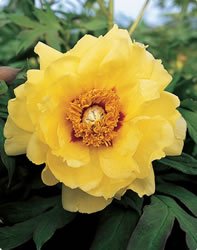 Peony - Tree - High Noon The Tree Peony High Noon, 'Paeonia', produces a refined double flower of the brightest yellow. High noon is an excellent grower and is a free-bloomer. The huge, ruffled, satin-like flowers are magnificent and the plant is super hardy! There was a time, many years ago in ancient China, when the only person who could own a tree peony was the Emperor himself. We're not sure what the penalty was for infringing this law, but it can't have been very pleasant. Fortunately for us, tree peonies are now slightly more available. There are very few plants that can compete with a tree peony in full bloom. They flower from late April to early May but the flowering season does vary from year to year. A mature plant can have in excess of a hundred flowers and these can be 10" or more across! The flowers range in color from maroon, crimson, scarlet, various shades of pink, to pure white. There are also tree peonies with yellow or purple flowers. The Chinese refer to the tree peony as 'Moutan'. This has been variously translated but probably means 'The Emperor Flower'. While the tree peony originated in China, it had found its way to Japan by the 8th Century AD. Japanese tree peonies tend to have less double flowers than their Chinese peers, and the flowers are more open and delicate. Growing only 4-5' tall, these exceptional Tree Peonies are sub-zero hardy and bloom for a lifetime.
|
Peony - Tree - Shima-nishiki The Tree Peony Shima-nishiki, 'Paeonia', is a rare two-toned beauty that has immense red and white double flowers. They grow 4-5' tall and make ideal specimen plants. This Tree Peony has huge, ruffled, satin-like flowers that are super hardy! Every garden needs a tree peony. There was a time, many years ago in ancient China, when the only person who could own a tree peony was the Emperor himself. We're not sure what the penalty was for infringing this law, but it can't have been very pleasant. Fortunately for us, tree peonies are now slightly more available. There are very few plants that can compete with a tree peony in full bloom. A mature plant can have in excess of a hundred flowers and these can be 10" or more across! Japanese tree peonies tend to have less double flowers than their Chinese peers, and the flowers are more open and delicate. Growing only 4-5' tall, these exceptional Tree Peonies are sub-zero hardy and bloom for a lifetime.
|
|
Peony - Tree - Koukamon The Tree Peony Koukamon, 'Paeonia', Deep maroon, produces a flower that is almost black towards the center. The flowers are huge, ruffled, satin-like and super hardy! Every garden needs a tree peony. There was a time, many years ago in ancient China, when the only person who could own a tree peony was the Emperor himself. We're not sure what the penalty was for infringing this law, but it can't have been very pleasant. Fortunately for us, tree peonies are now slightly more available. There are very few plants that can compete with a tree peony in full bloom. They flower from late April to early May but the flowering season does vary from year to year. A mature plant can have in excess of a hundred flowers and these can be 10" or more across! The flowers range in color from maroon, crimson, scarlet, various shades of pink, to pure white. There are also tree peonies with yellow or purple flowers. The Chinese refer to the tree peony as 'Moutan'. This has been variously translated but probably means 'The Emperor Flower'. While the tree peony originated in China, it had found its way to Japan by the 8th Century AD. Japanese tree peonies tend to have less double flowers than their Chinese peers, and the flowers are more open and delicate. Growing only 4-5' tall, these exceptional Tree Peonies are sub-zero hardy and bloom for a lifetime.
|
Peony - Tree - Seidei The Tree Peony Seidei, 'Paeonia', produces a delicate peachy-pink flower with soft pink edge. Every garden needs a tree peony. There was a time, many years ago in ancient China, when the only person who could own a tree peony was the Emperor himself. We're not sure what the penalty was for infringing this law, but it can't have been very pleasant. Fortunately for us, tree peonies are now slightly more available. There are very few plants that can compete with a tree peony in full bloom. A mature plant can have in excess of a hundred flowers and these can be 10" or more across! Japanese tree peonies tend to have less double flowers than their Chinese peers, and the flowers are more open and delicate. Growing only 4-5' tall, these exceptional Tree Peonies are sub-zero hardy and bloom for a lifetime.
|
|
Peony - Tree - Taiyo The Tree Peony Taiyo, 'Paeonia', produces bright scarlet blooms. Every garden needs a tree peony. There was a time, many years ago in ancient China, when the only person who could own a tree peony was the Emperor himself. We're not sure what the penalty was for infringing this law, but it can't have been very pleasant. Fortunately for us, tree peonies are now slightly more available. There are very few plants that can compete with a tree peony in full bloom. They flower from late April to early May but the flowering season does vary from year to year. A mature plant can have in excess of a hundred flowers and these can be 10" or more across! The flowers range in color from maroon, crimson, scarlet, various shades of pink, to pure white. There are also tree peonies with yellow or purple flowers. The Chinese refer to the tree peony as 'Moutan'. This has been variously translated but probably means 'The Emperor Flower'. While the tree peony originated in China, it had found its way to Japan by the 8th Century AD. Japanese tree peonies tend to have less double flowers than their Chinese peers, and the flowers are more open and delicate. Growing only 4-5' tall, these exceptional Tree Peonies are sub-zero hardy and bloom for a lifetime.
|
Peony - Tree - Renkaku The Tree Peony Renkaku, 'Paeonia', produces a cup shaped double white flower. These huge, ruffled, satin-like flowers are super hardy! Rare Colorful Imperial Tree Peonies are from Japan - The Finest Quality Available! Every garden needs a tree peony. There was a time, many years ago in ancient China, when the only person who could own a tree peony was the Emperor himself. We're not sure what the penalty was for infringing this law, but it can't have been very pleasant. Fortunately for us, tree peonies are now slightly more available. There are very few plants that can compete with a tree peony in full bloom. They flower from late April to early May but the flowering season does vary from year to year. A mature plant can have in excess of a hundred flowers and these can be 10" or more across! The flowers range in color from maroon, crimson, scarlet, various shades of pink, to pure white. There are also tree peonies with yellow or purple flowers. The Chinese refer to the tree peony as 'Moutan'. This has been variously translated but probably means 'The Emperor Flower'. While the tree peony originated in China, it had found its way to Japan by the 8th Century AD. Japanese tree peonies tend to have less double flowers than their Chinese peers, and the flowers are more open and delicate. Growing only 4-5' tall, these exceptional Tree Peonies are sub-zero hardy and bloom for a lifetime.
|
 Peony - Tree - Kamata-fuji The Tree Peony Kamata-fuji, 'Paeonia', produces full double dark pink blooms. Every garden needs a tree peony. There was a time, many years ago in ancient China, when the only person who could own a tree peony was the Emperor himself. We're not sure what the penalty was for infringing this law, but it can't have been very pleasant. Fortunately for us, tree peonies are now slightly more available. There are very few plants that can compete with a tree peony in full bloom. They flower from late April to early May but the flowering season does vary from year to year. A mature plant can have in excess of a hundred flowers and these can be 10" or more across! The flowers range in color from maroon, crimson, scarlet, various shades of pink, to pure white. There are also tree peonies with yellow or purple flowers. The Chinese refer to the tree peony as 'Moutan'. This has been variously translated but probably means 'The Emperor Flower'. While the tree peony originated in China, it had found its way to Japan by the 8th Century AD. Japanese tree peonies tend to have less double flowers than their Chinese peers, and the flowers are more open and delicate. Growing only 4-5' tall, these exceptional Tree Peonies are sub-zero hardy and bloom for a lifetime.
|
Peony - Tree - Shimadaijin The Tree Peony Shimadaijin, 'Paeonia', produces flowers that are large, purplish-red. Every garden needs a tree peony. There was a time, many years ago in ancient China, when the only person who could own a tree peony was the Emperor himself. We're not sure what the penalty was for infringing this law, but it can't have been very pleasant. Fortunately for us, tree peonies are now slightly more available. There are very few plants that can compete with a tree peony in full bloom. They flower from late April to early May but the flowering season does vary from year to year. A mature plant can have in excess of a hundred flowers and these can be 10" or more across! The flowers range in color from maroon, crimson, scarlet, various shades of pink, to pure white. There are also tree peonies with yellow or purple flowers. The Chinese refer to the tree peony as 'Moutan'. This has been variously translated but probably means 'The Emperor Flower'. While the tree peony originated in China, it had found its way to Japan by the 8th Century AD. Japanese tree peonies tend to have less double flowers than their Chinese peers, and the flowers are more open and delicate. Growing only 4-5' tall, these exceptional Tree Peonies are sub-zero hardy and bloom for a lifetime.
|
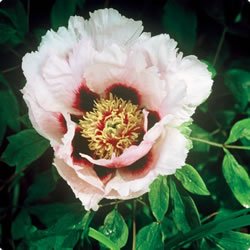 Peony - Tree - Rockii The Tree Peony Rockii, 'Paeonia', is from Moutan in China. The single flowers are 7" across and they are a pink to silvery-white. Each petal is marked with a maroon blotch. It is known for its size and resistance to extreme cold, drought, diseases and pests. With its rich colors, various shapes, strong flexibility and simple maintenance, it has become the new and resplendent star in the family of the peony. Rockii peonies are different from shrubs because of their summer green, bushy, lignifying growth. Therefore they are called tree peonies.
|
Japanese Tree Lilac The Japanese Tree Lilac, Syringa reticulata, is a handsome, multi-stemmed, tree or large shrub that bears large creamy white flowers in large panicles in June and July. This is a clump form and will have multiple stems. Reddish-brown, cherry-like bark, and clean, dark green leaves enhance seasonal interest. Japanese Tree Lilac has spreading branches, developing a somewhat oval-rounded to vase-shaped crown. 2002 Iowa Tree of the Year. Lilacs need at least 6 hours of direct sunlight per day to produce flower buds. Too much nitrogen can lead to lush green foliage and fewer flower buds. Lawn fertilizer contains nitrogen, so avoid using it around the base of the lilac tree. Prune immediately after flowering to avoid removing flower buds. Water routinely to maintain a healthy and beautiful plant. Tree lilacs are dependable urban trees, including as parking lot or boulevard plantings, which tolerate a wide range of conditions.
|
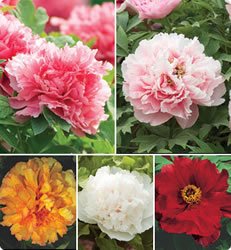 Peony - Tree - The Emperor's Collection The The Emperor's Tree Peony Collection, 'Paeonia', can be planted all together for a stunning early spring garden. A garden full of powerfully beautiful peony flowers is easy and instant with this knockout collection of Emperor's Tree Peonies. Each bareroot peony will live for generations in the landscape producing more and more flowers each year. The yellow ruffled petals of 'Kinkaku' bring out the mustard-yellow center of the blood red 'Taiyo.' 'Yoshino Gawa''s pastel pink flowers appear to be a cross between the powdery white 'Renkaku' and deep pink 'Seidei.'
|
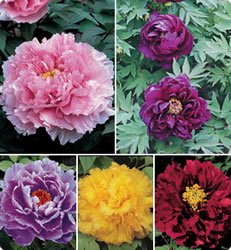 Peony - Tree - The Dowager's Collection The The Dowager's Tree Peony Collection , 'Paeonia', consists of five Tree Peonies. The collection includes a selection of double pink, double yellow, soft lavender, amethyst purple, and deep garnet flowers. Fill your garden with large peony flowers on shrubs with attractive foliage that resembles fern fronds. Perfect to add to your existing Tree Peony collection or start a brand new collection. Plant them where they will receive at least six hours of sun each day and give them plenty of bloom boosting fertilizer to promote a bounty of blooms.
|
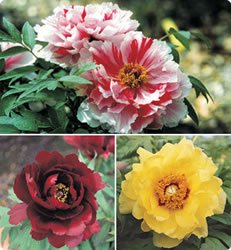 Peony - Tree - Shimane Island Collection The Shimane Island Tree Peony Collection, 'Paeonia', contains 3 plants, 1 each of High Noon, Koukamon, & Shima-nishiki. These Tree Peonies display huge, ruffled, satin-like flowers that are super hardy! Every garden needs a tree peony. There was a time, many years ago in ancient China, when the only person who could own a tree peony was the Emperor himself. We're not sure what the penalty was for infringing this law, but it can't have been very pleasant. Fortunately for us, tree peonies are now slightly more available. There are very few plants that can compete with a tree peony in full bloom. They flower from late April to early May but the flowering season does vary from year to year. A mature plant can have in excess of a hundred flowers and these can be 10" or more across! The flowers range in color from maroon, crimson, scarlet, various shades of pink, to pure white. There are also tree peonies with yellow or purple flowers. The Chinese refer to the tree peony as 'Moutan'. This has been variously translated but probably means 'The Emperor Flower'. While the tree peony originated in China, it had found its way to Japan by the 8th Century AD. Japanese tree peonies tend to have less double flowers than their Chinese peers, and the flowers are more open and delicate. Growing only 4-5' tall, these exceptional Tree Peonies are sub-zero hardy and bloom for a lifetime.
|
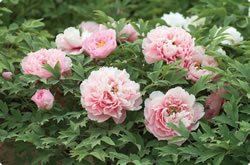 Peony - Tree - Yoshino gawa The Tree Peony Yoshino gawa, 'Paeonia', produces enormous bright pale pink of rare beauty. Every garden needs a tree peony. There was a time, many years ago in ancient China, when the only person who could own a tree peony was the Emperor himself. We're not sure what the penalty was for infringing this law, but it can't have been very pleasant. Fortunately for us, tree peonies are now slightly more available. There are very few plants that can compete with a tree peony in full bloom. They flower from late April to early May but the flowering season does vary from year to year. A mature plant can have in excess of a hundred flowers and these can be 10" or more across! The flowers range in color from maroon, crimson, scarlet, various shades of pink, to pure white. There are also tree peonies with yellow or purple flowers. The Chinese refer to the tree peony as 'Moutan'. This has been variously translated but probably means 'The Emperor Flower'. While the tree peony originated in China, it had found its way to Japan by the 8th Century AD. Japanese tree peonies tend to have less double flowers than their Chinese peers, and the flowers are more open and delicate. Growing only 4-5' tall, these exceptional Tree Peonies are sub-zero hardy and bloom for a lifetime.
|
 Peony - Tree - High Noon The Tree Peony High Noon, 'Paeonia', produces a refined double flower of the brightest yellow. High noon is an excellent grower and is a free-bloomer. The huge, ruffled, satin-like flowers are magnificent and the plant is super hardy! There was a time, many years ago in ancient China, when the only person who could own a tree peony was the Emperor himself. We're not sure what the penalty was for infringing this law, but it can't have been very pleasant. Fortunately for us, tree peonies are now slightly more available. There are very few plants that can compete with a tree peony in full bloom. They flower from late April to early May but the flowering season does vary from year to year. A mature plant can have in excess of a hundred flowers and these can be 10" or more across! The flowers range in color from maroon, crimson, scarlet, various shades of pink, to pure white. There are also tree peonies with yellow or purple flowers. The Chinese refer to the tree peony as 'Moutan'. This has been variously translated but probably means 'The Emperor Flower'. While the tree peony originated in China, it had found its way to Japan by the 8th Century AD. Japanese tree peonies tend to have less double flowers than their Chinese peers, and the flowers are more open and delicate. Growing only 4-5' tall, these exceptional Tree Peonies are sub-zero hardy and bloom for a lifetime.
|
Peony - Tree - Koukamon The Tree Peony Koukamon, 'Paeonia', Deep maroon, produces a flower that is almost black towards the center. The flowers are huge, ruffled, satin-like and super hardy! Every garden needs a tree peony. There was a time, many years ago in ancient China, when the only person who could own a tree peony was the Emperor himself. We're not sure what the penalty was for infringing this law, but it can't have been very pleasant. Fortunately for us, tree peonies are now slightly more available. There are very few plants that can compete with a tree peony in full bloom. They flower from late April to early May but the flowering season does vary from year to year. A mature plant can have in excess of a hundred flowers and these can be 10" or more across! The flowers range in color from maroon, crimson, scarlet, various shades of pink, to pure white. There are also tree peonies with yellow or purple flowers. The Chinese refer to the tree peony as 'Moutan'. This has been variously translated but probably means 'The Emperor Flower'. While the tree peony originated in China, it had found its way to Japan by the 8th Century AD. Japanese tree peonies tend to have less double flowers than their Chinese peers, and the flowers are more open and delicate. Growing only 4-5' tall, these exceptional Tree Peonies are sub-zero hardy and bloom for a lifetime.
|
|
Peony - Tree - Taiyo The Tree Peony Taiyo, 'Paeonia', produces bright scarlet blooms. Every garden needs a tree peony. There was a time, many years ago in ancient China, when the only person who could own a tree peony was the Emperor himself. We're not sure what the penalty was for infringing this law, but it can't have been very pleasant. Fortunately for us, tree peonies are now slightly more available. There are very few plants that can compete with a tree peony in full bloom. They flower from late April to early May but the flowering season does vary from year to year. A mature plant can have in excess of a hundred flowers and these can be 10" or more across! The flowers range in color from maroon, crimson, scarlet, various shades of pink, to pure white. There are also tree peonies with yellow or purple flowers. The Chinese refer to the tree peony as 'Moutan'. This has been variously translated but probably means 'The Emperor Flower'. While the tree peony originated in China, it had found its way to Japan by the 8th Century AD. Japanese tree peonies tend to have less double flowers than their Chinese peers, and the flowers are more open and delicate. Growing only 4-5' tall, these exceptional Tree Peonies are sub-zero hardy and bloom for a lifetime.
|
Peony - Tree - Renkaku The Tree Peony Renkaku, 'Paeonia', produces a cup shaped double white flower. These huge, ruffled, satin-like flowers are super hardy! Rare Colorful Imperial Tree Peonies are from Japan - The Finest Quality Available! Every garden needs a tree peony. There was a time, many years ago in ancient China, when the only person who could own a tree peony was the Emperor himself. We're not sure what the penalty was for infringing this law, but it can't have been very pleasant. Fortunately for us, tree peonies are now slightly more available. There are very few plants that can compete with a tree peony in full bloom. They flower from late April to early May but the flowering season does vary from year to year. A mature plant can have in excess of a hundred flowers and these can be 10" or more across! The flowers range in color from maroon, crimson, scarlet, various shades of pink, to pure white. There are also tree peonies with yellow or purple flowers. The Chinese refer to the tree peony as 'Moutan'. This has been variously translated but probably means 'The Emperor Flower'. While the tree peony originated in China, it had found its way to Japan by the 8th Century AD. Japanese tree peonies tend to have less double flowers than their Chinese peers, and the flowers are more open and delicate. Growing only 4-5' tall, these exceptional Tree Peonies are sub-zero hardy and bloom for a lifetime.
|
 Peony - Tree - Kamata-fuji The Tree Peony Kamata-fuji, 'Paeonia', produces full double dark pink blooms. Every garden needs a tree peony. There was a time, many years ago in ancient China, when the only person who could own a tree peony was the Emperor himself. We're not sure what the penalty was for infringing this law, but it can't have been very pleasant. Fortunately for us, tree peonies are now slightly more available. There are very few plants that can compete with a tree peony in full bloom. They flower from late April to early May but the flowering season does vary from year to year. A mature plant can have in excess of a hundred flowers and these can be 10" or more across! The flowers range in color from maroon, crimson, scarlet, various shades of pink, to pure white. There are also tree peonies with yellow or purple flowers. The Chinese refer to the tree peony as 'Moutan'. This has been variously translated but probably means 'The Emperor Flower'. While the tree peony originated in China, it had found its way to Japan by the 8th Century AD. Japanese tree peonies tend to have less double flowers than their Chinese peers, and the flowers are more open and delicate. Growing only 4-5' tall, these exceptional Tree Peonies are sub-zero hardy and bloom for a lifetime.
|
Peony - Tree - Shimadaijin The Tree Peony Shimadaijin, 'Paeonia', produces flowers that are large, purplish-red. Every garden needs a tree peony. There was a time, many years ago in ancient China, when the only person who could own a tree peony was the Emperor himself. We're not sure what the penalty was for infringing this law, but it can't have been very pleasant. Fortunately for us, tree peonies are now slightly more available. There are very few plants that can compete with a tree peony in full bloom. They flower from late April to early May but the flowering season does vary from year to year. A mature plant can have in excess of a hundred flowers and these can be 10" or more across! The flowers range in color from maroon, crimson, scarlet, various shades of pink, to pure white. There are also tree peonies with yellow or purple flowers. The Chinese refer to the tree peony as 'Moutan'. This has been variously translated but probably means 'The Emperor Flower'. While the tree peony originated in China, it had found its way to Japan by the 8th Century AD. Japanese tree peonies tend to have less double flowers than their Chinese peers, and the flowers are more open and delicate. Growing only 4-5' tall, these exceptional Tree Peonies are sub-zero hardy and bloom for a lifetime.
|
|
Dr. Earth Organic 9™ Fruit Tree Fertilizer - 4 lb Dr. Earth Organic 9™ Fruit Tree Fertilizer (4 lb) is 100% natural and organic and is used to stimulate and create hearty root development, encourage more abundant sets, and grow more nutritious fruits with consistent results. This fertilizer eliminates the need for chemical fertilizers, when used as directed. Dr. Earth Organic 9™ Fruit Tree Fertilizer has a 100% natural/organic formula that provides optimum levels of essential plant nutrients, including important micronutrients and minerals. With its superior blend of fish bone meal, feather meal, alfalfa meal, mined potassium sulfate, soft rock phosphate, and seaweed extract, it is used for feeding fruits trees like apples, peaches, apricots, grapes, all berries, and all nut trees.
|
Bonide Fruit Tree Spray - 8 oz Concentrate The Bonide Fruit Tree Spray (8 oz.) is a complete liquid fruit tree spray that is excellent for the home orchardist. This spray is truly effective in controlling both insects and diseases on fruit trees, flowers, evergreens and strawberries. When mixing, use 1 1/2 to 2 1/2 tablespoons per gallon of water. Bonide Fruit Tree Spray mixes with water instantly, so is very easy to use. When applying this spray it is best to apply it by using a hose-end sprayer or tank sprayer. Not For Sale in these U.S. States: CA.
|
|
Bonide Fruit Tree Spray - Pint Concentrate The Bonide Fruit Tree Spray (Pint) is a complete liquid fruit tree spray that is excellent for the home orchardist. This spray is truly effective in controlling both insects and diseases on fruit trees, flowers, evergreens and strawberries. When mixing, use 1 1/2 to 2 1/2 tablespoons per gallon of water. Bonide Fruit Tree Spray mixes with water instantly with no pre-mixing, so is very easy to use. When applying this spray it is best to apply it by using a hose-end sprayer or tank sprayer. Not For Sale in these U.S. States: CA.
|
Bonide Fruit Tree Spray - Qt Concentrate The Bonide Fruit Tree Spray (Quart) is a complete liquid fruit tree spray that is excellent for the home orchardist. This spray is truly effective in controlling both insects and diseases on fruit trees, flowers, evergreens and strawberries. When mixing, use 1 1/2 to 2 1/2 tablespoons per gallon of water. Bonide Fruit Tree Spray mixes with water instantly with no pre-mixing, so is very easy to use. When applying this spray it is best to apply it by using a hose-end sprayer or tank sprayer. Not For Sale in these U.S. States: CA.
|

Join "Garden Notes" and plan for Harvest Success as you track and record your gardening progress. Your Free Personal Garden Journal has pages for jotting down notes on the seeds you start, your new plantings, when you fertilized, and even a graph to plot a new garden.
I didn't want to see another internet "eBook" on growing anything, but my husband signed up for Kacper's free report and I have to tell you, it is WELL worth the read. If you think you know everything about growing tomatoes, I challenge you to read Kacper's report. HIGHLY recommended!

Based entirely on organic gardening principles. This says it all. Joy's book has been fully revised and updated and includes extensive new reading, particularly on oriental and fruiting vegetables, and did I mention, is now entirely based on organic gardening practices. Read More...
